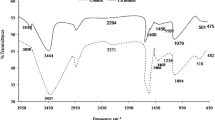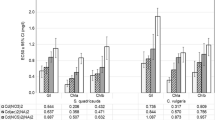Abstract
A quantitative study of cadmium binding to three different growth media for nitrogen-fixing cyanobacteria was done with the aid of a solid state ion-specific electrode. Kratz and Myers modified medium and Arnon medium bound large amounts of Cd2+, BG110 medium had less binding capacity. Of the media components, phosphate ion showed the greatest ability to bind Cd2+. Different pHs, the size of cell inoculum and two buffers (Tricine and HEPES, 25 mM) also changed the availability of free cadmium ion in solution.
The effect of free Cd2+ ion towards the cyanobacteriumNostoc UAM 208, isolated from a heavy metal polluted environment, also was tested. The effective concentration affecting 50% of population (EC50), at 120 h of exposure, was less for nitrogenase activity (0.26 μg/mL) than for growth (0.55 μg/mL), suggesting that this enzyme activity is more sensitive to cadmium than growth. Furthermore, cadmium toxicity was influenced by the addition of buffers to the growth medium. In the presence of buffer, Tricine (25 mM), growth and nitrogenase activity was reduced by 50% at a total cadmium concentration of about 115 μg/mL, although no free ion was detected in this case.
These results suggest that although generally cadmium toxicity is a function of free metal ion concentration, this can also vary in the presence of complexing agents.
Similar content being viewed by others
References
Arnon DI, McSwain BD, Tsujimoto HY, Wada K (1974) Photochemical activity and components of membrane preparations from blue-green algae. 1. Coexistence of two photosystems in relation to chlorophyll a and removal of phycocyanin. Biochim Biophys Acta 357:231–245
Babich H, Stotzky G (1977) Sensitivity of various bacteria, including actinomycetes, and fungi to cadmium and the influence of pH on sensitivity. Appl Environ Microbiol 33:681–695
—, — (1978) Effects of cadmium on the biota: Influence of environmental factors. Adv Appl Microbiol 23:55–117
—, — (1983) Influence of chemical speciation on the toxicity of heavy metals. In J. O. Nriagu (ed) Aquatic toxicology. Advances in environmental science and technology. John Wiley & Sons, NY, 13:1–46
Duxbury T (1985) Ecological aspects of heavy metal responses in microorganisms. Adv Microb Ecol 8:185–235
Fernandez-Valiente E, Leganes F (1989) Regulatory effect of pH and incident irradiance on the levels of nitrogenase activity in the cyanobacteriumNostoc UAM 205. J Plant Physiol 135:623–627
Gipps JF, Coller BAW (1980) Effect of physical and culture conditions on uptake of cadmium byChlorella pyrenoidosa. Aus J Mar Freshwat 31:747–755
Kratz WA, Myers J (1955) Nutrition and growth of several bluegreen algae. Am J Bot 42:282–287
Laegreid M, Alstad J, Klaveness D, Selp HM (1983) Seasonal variation of cadmium toxicity towards the algaSelenastrum capricornatum printz in two lakes with different humus content. Environ Sci Technol 17:357–361
Laube VM, McKenzie CN, Kushner DJ (1980) Strategies of response to copper, cadmium, and lead by a blue-green and a green alga. Can J Microbiol 26:1300–1311
Mateo P, Bonilla I, Fernandez-Valiente E, Sanchez-Maeso E (1986) Essentiality of boron for dinitrogen fixation inAnabaena PCC 7119. Plant Physiol 81:430–433
Michnowickz J, Weaks J (1983) Reversal of trace element induced toxicity inSelenastrum capricornutum. Proc Ann Meet Am Soc, p 137
Nriagu JO, Pacyna JM (1988) Quantitative assessment of worldwide contamination of air, water, and soils by trace elements. Nature 333:134–139
Peterson HG, Healey FP, Wagemann R (1984) Metal toxicity to algae: A highly pH-dependent phenomenon. Can J Fish Aquat Sci 41:974–979
Pettersson A, Hällbom L, Bergman B (1985) Physiological and structural responses of the cyanobacteriumAnabaena cylindrica to aluminium. Physiol Plant 63:153–158
Rachlin JW, Jensen TE, Warkentine B (1984) The toxicological response of the algaAnabaena flos-aquae to cadmium. Arch Environ Contam Toxicol 13:143–151
Rachlin JW, Jensen TE, Warkentine BE (1985) Morphometric analysis of the response ofAnabaena flos-aquae andAnabaena variabilis (Cyanophyceae) to selected concentrations of zinc. Arch Environ Contam Toxicol 14:395–402
Ramamoorthy S, Kushner DJ (1975) Binding of mercuric and other heavy metal ions by microbial growth media. Microbiol Ecol 2:162–176
Rippka R (1988) Recognition and identification of cyanobacteria. Methods in Enzymology 167:28–67
Rippka R, Deruelles J, Waterbury JB, Herdman M, Stanier RY (1979) Generic assignments, strain histories and properties of pure cultures of cyanobacteria. J Gen Microbiol 111:1–61
Sanchez-Maeso E, Fernandez-Piñas F, Garcia-Gonzalez M, Fernandez-Valiente E (1987) Sodium requirement for photosynthesis and its relationship with dinitrogen fixation and the external CO2 concentration in cyanobacteria. Plant Physiol 85:585–587
Singh SP, Pandey AK (1981) Cadmium toxicity in a cyanobacterium: Effect of modifying factors. Environ Exp Bot 21:257–265
Singh SP, Yadava V (1987) Factors affecting cadmium toxicity inAnacystis nidulans. J Environ Biol 8:245–256
Starodub ME, Wong PTS, Mayfield CI, Chau YK (1987) Influence of complexation and pH on individual and combined heavy metal toxicity to a freshwater green alga. Can J Fish Aquat Sci 44:1173–1180
Stratton GW, Corke ChT (1979) The effect of cadmium ion on the growth, photosynthesis, and nitrogenase activity ofAnabaena inaequalis. Chemosphere 8:277–282
Trevors JT, Stratton GW, Gadd GM (1986) Cadmium transport, resistance, and toxicity in bacteria, algae, and fungi. Can J Microbiol 32:447–464
Vymazal J (1987) Toxicity and accumulation of cadmium with respect to algae and cyanobacteria: A review. Toxicity Assessment, An International Quarterly, John Wiley & Sons, NY, 2:387–415
Author information
Authors and Affiliations
Rights and permissions
About this article
Cite this article
Fernandez-Piñias, F., Mateo, P. & Bonilla, I. Binding of cadmium by cyanobacterial growth media: Free ion concentration as a toxicity index to the cyanobacteriumNostoc UAM 208. Arch. Environ. Contam. Toxicol. 21, 425–431 (1991). https://doi.org/10.1007/BF01060366
Received:
Revised:
Issue Date:
DOI: https://doi.org/10.1007/BF01060366




